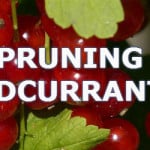Last updated on January 27th, 2022
Our site is reader supported, this means we may earn a small commission from Amazon and other affiliates when you buy through links on our site.
If you are making jams, pies or tarts it’s best to pick slightly under-ripe gooseberries around June. Leave the rest to ripen and they can be picked around late July when they are swollen and sweet.
If you want to grow a fruit bush, you can’t beat planting Gooseberries bushes. The fruit can be used for making pies, jams, sauces and tarts, and later, when the fruit is sweet and ripe, they taste amazing picked straight from the bush and eaten fresh.
There are quite a few varieties of gooseberry plants, some are sweeter than others, and whilst some might produce a sweeter fruit, others may be more resistant to diseases such as gooseberry mildew and grow better in heavier soils.
When to harvest gooseberries
Gooseberries produce fruit towards the base of the previous year’s branches so winter pruning is essential to get the best harvest. Gooseberries are best picked twice, pick the more green under-ripe fruit and remove around half (this is known as thinning) and this is usually done around June. These can be used for cooking.
A few weeks later, usually around July the rest of the fruit should be ready for picking.
When are gooseberries ripe and ready for the final pick?
Once the remaining fruit is soft to touch they are usually ready for picking. They will be full of natural sugars and sweetness. Keep trying them fresh from the bush until you are happy they are ripe enough.
The local blackbirds usually let you know because they start to make an appearance and take the fruits.
Our favourite varieties
- Garden centre quality plant supplied in a 3L Pot
- Excellent variety specifically bred for hardiness and disease resistance
- Consistently prolific cropper of large, well flavoured fruit
- Ideal variety for all purposes
- Cropping season: mid July
- Garden centre quality plant supplied in a 3L Pot
- Excellent variety specifically bred for hardiness and disease resistance
- Greenish yellow berries that have a unique aromatic flavour
- Ideal variety for all purposes
- Cropping season: mid July
No products found.
Protecting the buds and the fruit
Birds take a liking to both the new buds and the fruit so you may want to cover your gooseberry with a fine garden netting to protect the fruit.
Another problem many gardeners have is sawfly caterpillars that strip every leaf off the plant leaving it bare. Watch out for the first signs of them and handpick them off if possible and if this proves ineffective you can try spraying with an insecticide that is suitable for fruit bushes.
Correct pruning (which is done in winter) will help promote more fruit and help light get to the fruit, this will aid the ripening of fruit. Pruning also helps leave the centre of the plant open making picking fruit easier and improving air circulation which also helps to prevent mildew.
Gooseberry mildew
This mildew is easily identifiable by the powdery grey fungus that affects the leaves, stems and even fruit.
Treating should be done by removing any leaves and stems affected as soon as it is noticeable and burn to dispose of them. Spray affected plants with a fungicide that contains ‘myclobutanil’. Better air circulation will help prevent it so space plants 5ft apart and prune in winter.
Growing tips
- Planting in a exposed windy site will help deter sawfly and prevent mildew. Plants in sheltered sites seem to get attacked more often.
- Keep plants watered in summer, especially when the fruit is forming.
- Avoid applying fertiliser and apply plenty of potash to promote more flowers and fruit. Fertiliser will encourage new foliage growth that will attract sawflies, which will lay their eggs and when they hatch they will strip plants of their leaves.
Best Gooseberry varieties
There are over 150 cultivars of gooseberry plants but below are our top five recommended varieties that will perform well, produce large crops and grow well in most gardens.
- ‘Invicta’
- ‘Langley Gage’
- ‘Whitesmith’
- ‘Greenfinch’
- ‘Whinham’s Industry’
Image credit: wikimedia.org
Last update on 2024-04-20 / Affiliate links / Images from Amazon Product Advertising API






1 Comment
I have a number of plants on the farm, looking forward to picking and making a few pie’s, Thanks for the Info !